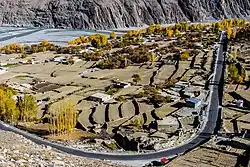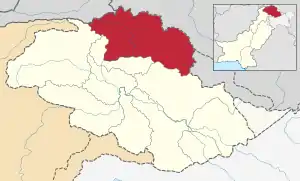Hunza District
ضلع ہنزہ | |
|---|---|
District of Gilgit-Baltistan administered by Pakistan[1] | |
 Hussaini Village in Gojal (Upper Hunza) | |
Interactive map of Hunza district | |
 A map showing Pakistani-administered Gilgit-Baltistan (shaded in sage green) in the disputed Kashmir region[1] | |
| Coordinates (Karimabad, Gilgit=Baltistan): 36°34′N 75°06′E / 36.567°N 75.100°E | |
| Administering country | Pakistan |
| Territory | Gilgit-Baltistan |
| Division | Gilgit Division |
| Headquarters | Karimabad |
| Government | |
| • Type | District Administration |
| • Deputy Commissioner | N/A |
| • District Police Officer | N/A |
| • District Health Officer | N/A |
| Area | |
| • Total | 11,660 km2 (4,500 sq mi) |
| Population (1998) | |
| • Total | 243,324 |
| • Density | 6.4/km2 (17/sq mi) |
| Number of tehsils | 2 |
The Hunza District (Urdu: ضلع ہنزہ) is a district of Pakistan-administered Gilgit-Baltistan in the disputed Kashmir region.[1] Hunza district is one of the 14 districts of the Pakistani-administered province of Gilgit-Baltistan. It was established in 2015 by the division of the Hunza–Nagar District in accordance with a government decision to establish more administrative units in Gilgit-Baltistan.[2] The district headquarters is the town of Karimabad.

Geography
The Hunza District is bounded on the north and east by the Kashgar Prefecture of China's Xinjiang Uyghur Autonomous Region, on the south by the Nagar District and the Shigar District, on the west by the Ghizer District, and on the north-west by the Wakhan District of Afghanistan's Badakhshan Province. The Hunza District represents the northernmost region of the Indian subcontinent.
Hunza is home to the historic passes through the Karakoram Mountains (the Killik, Mintaka, Khunjerab, and Shimshal passes) through which trade and religion passed between Central Asia, China, and India for centuries. The present-day Karakoram Highway passes through the Khunjerab Pass to enter China's Xinjiang Uyghur Autonomous Region.
History
Historian Ahmad Hassan Dani established that the Sakas (Scythians) used the Karakoram route to invade Taxila. The Sacred Rock of Hunza has petroglyphs of mounted horsemen and ibex, along with Kharosthi inscriptions that list the names of Saka and Pahlava rulers.[3] The rock also contains inscriptions from the Kushan period, showing the Saka and Kushan suzerainty over the Hunza and Gilgit regions.[4]
.png.webp)
Hunza began to separate from the Gilgit region as a separate state around 997 A.D., but decisive separation occurred with the establishment of the Ayash ruling family in the 15th century. The neighbouring Nagar state also separated in the same manner, and internecine battles between the two states were endemic.[5] Following the invasion of Kashmir by the Mughul nobleman Mirza Haidar Dughlat, the Mir of Hunza established diplomatic relations with Kashgaria (Yarkand Khanate). After Kashgaria came under Chinese control, he continued relations with Kashgaria by paying an annual tribute of gold dust to the Chinese government in Yarkand. In return for that token tribute, Hunza enjoyed territorial rights in the Raskam Valley and grazing rights in the Taghdumbash Pamir.[6][7]
British era
After the British suzerainty was established over the Kashmir region in 1846, the British made Hunza subject to the Maharaja of Jammu and Kashmir. Thus Hunza was in the anomalous position of being subject to two sovereign powers at the same time, immensely complicating the relations between British India and the Chinese empire. The practice of tribute to China was eventually stopped in 1930.[7]
After 1947
After the partition of India into the present-day India and Pakistan in 1947, the Maharaja of Jammu and Kashmir acceded his state to India to in order to defend it against an invasion by Pakistani tribesmen. A rebellion in Gilgit then overthrew the Maharaja's authority. The Mir of Hunza subsequently acceded his state to Pakistan, but the accession was never formally accepted, due to the Kashmir dispute in the United Nations.
Administration
Administratively, the Hunza District comprises two tehsils, the Aliabad Tehsil and the Gojal Tehsil. The villages of lower Hunza and central Hunza are located in the Aliabad Tehsil, whereas the villages from the Attabad Lake up to the Khunjerab Pass are located in the Gojal Tehsil. In lower Hunza, Shina is the main language, whereas in central Hunza, the dominant language is Burushashki, and in upper Hunza, Wakhi is the main language. District administration is exercised by the Deputy Commissioner (DC), with the assistance of an assistant commissioner. The Hunza police force is commanded by the Superintendent of Police (SP).
Religion
The population of Hunza District is predominantly Muslim, with 89% Nizari Ismaili muslims, 7% Asnashiri Muslims, and 4% Sunni Muslims.
References
- 1 2 3 The application of the term "administered" to the various regions of Kashmir and a mention of the Kashmir dispute is supported by the tertiary sources (a) through (e), reflecting due weight in the coverage. Although "controlled" and "held" are also applied neutrally to the names of the disputants or to the regions administered by them, as evidenced in sources (h) through (i) below, "held" is also considered politicized usage, as is the term "occupied," (see (j) below).
(a) Kashmir, region Indian subcontinent, Encyclopaedia Britannica, retrieved 15 August 2019 (subscription required) Quote: "Kashmir, region of the northwestern Indian subcontinent ... has been the subject of dispute between India and Pakistan since the partition of the Indian subcontinent in 1947. The northern and western portions are administered by Pakistan and comprise three areas: Azad Kashmir, Gilgit, and Baltistan, the last two being part of a territory called the Northern Areas. Administered by India are the southern and southeastern portions, which constitute the state of Jammu and Kashmir but are slated to be split into two union territories.";
(b) Pletcher, Kenneth, Aksai Chin, Plateau Region, Asia, Encyclopaedia Britannica, retrieved 16 August 2019 (subscription required) Quote: "Aksai Chin, Chinese (Pinyin) Aksayqin, portion of the Kashmir region, at the northernmost extent of the Indian subcontinent in south-central Asia. It constitutes nearly all the territory of the Chinese-administered sector of Kashmir that is claimed by India to be part of the Ladakh area of Jammu and Kashmir state.";
(c) "Kashmir", Encyclopedia Americana, Scholastic Library Publishing, 2006, p. 328, ISBN 978-0-7172-0139-6 C. E Bosworth, University of Manchester Quote: "KASHMIR, kash'mer, the northernmost region of the Indian subcontinent, administered partlv by India, partly by Pakistan, and partly by China. The region has been the subject of a bitter dispute between India and Pakistan since they became independent in 1947";
(d) Osmańczyk, Edmund Jan (2003), Encyclopedia of the United Nations and International Agreements: G to M, Taylor & Francis, pp. 1191–, ISBN 978-0-415-93922-5 Quote: "Jammu and Kashmir: Territory in northwestern India, subject to a dispute between India and Pakistan. It has borders with Pakistan and China."
(e) Talbot, Ian (2016), A History of Modern South Asia: Politics, States, Diasporas, Yale University Press, pp. 28–29, ISBN 978-0-300-19694-8 Quote: "We move from a disputed international border to a dotted line on the map that represents a military border not recognized in international law. The line of control separates the Indian and Pakistani administered areas of the former Princely State of Jammu and Kashmir.";
(f) Skutsch, Carl (2015) [2007], "China: Border War with India, 1962", in Ciment, James (ed.), Encyclopedia of Conflicts Since World War II (2nd ed.), London and New York: Routledge, p. 573, ISBN 978-0-7656-8005-1,The situation between the two nations was complicated by the 1957–1959 uprising by Tibetans against Chinese rule. Refugees poured across the Indian border, and the Indian public was outraged. Any compromise with China on the border issue became impossible. Similarly, China was offended that India had given political asylum to the Dalai Lama when he fled across the border in March 1959. In late 1959, there were shots fired between border patrols operating along both the ill-defined McMahon Line and in the Aksai Chin.
(g) Clary, Christopher, The Difficult Politics of Peace: Rivalry in Modern South Asia, Oxford and New York: Oxford University Press, p. 109, ISBN 9780197638408,Territorial Dispute: The situation along the Sino-Indian frontier continued to worsen. In late July (1959), an Indian reconnaissance patrol was blocked, "apprehended," and eventually expelled after three weeks in custody at the hands of a larger Chinese force near Khurnak Fort in Aksai Chin. ... Circumstances worsened further in October 1959, when a major class at Kongka Pass in eastern Ladakh led to nine dead and ten captured Indian border personnel, making it by far the most serious Sino-Indian class since India's independence.
(h) Bose, Sumantra (2009), Kashmir: Roots of Conflict, Paths to Peace, Harvard University Press, pp. 294, 291, 293, ISBN 978-0-674-02855-5 Quote: "J&K: Jammu and Kashmir. The former princely state that is the subject of the Kashmir dispute. Besides IJK (Indian-controlled Jammu and Kashmir. The larger and more populous part of the former princely state. It has a population of slightly over 10 million, and comprises three regions: Kashmir Valley, Jammu, and Ladakh.) and AJK ('Azad" (Free) Jammu and Kashmir. The more populous part of Pakistani-controlled J&K, with a population of approximately 2.5 million.), it includes the sparsely populated "Northern Areas" of Gilgit and Baltistan, remote mountainous regions which are directly administered, unlike AJK, by the Pakistani central authorities, and some high-altitude uninhabitable tracts under Chinese control."
(i) Fisher, Michael H. (2018), An Environmental History of India: From Earliest Times to the Twenty-First Century, Cambridge University Press, p. 166, ISBN 978-1-107-11162-2 Quote: "Kashmir’s identity remains hotly disputed with a UN-supervised “Line of Control” still separating Pakistani-held Azad (“Free”) Kashmir from Indian-held Kashmir.";
(j) Snedden, Christopher (2015), Understanding Kashmir and Kashmiris, Oxford University Press, p. 10, ISBN 978-1-84904-621-3 Quote:"Some politicised terms also are used to describe parts of J&K. These terms include the words 'occupied' and 'held'." - ↑ "Dividing governance: Three new districts notified in G-B - The Express Tribune". The Express Tribune. 25 July 2015. Retrieved 2016-03-10.
- ↑ Puri 1996, pp. 185–186.
- ↑ Harmatta 1996, p. 426.
- ↑ Dani 1998, pp. 223, 224.
- ↑ Pirumshoev & Dani 2003, p. 243.
- 1 2 Mehra, An "agreed" frontier 1992, pp. 1–14.
Bibliography
- Dani, Ahmad Hasan (1998), "The Western Himalayan States" (PDF), in M. S. Asimov; C. E. Bosworth (eds.), History of Civilizations of Central Asia, Vol. IV, Part 1 — The age of achievement: A.D. 750 to the end of the fifteenth century — The historical, social and economic setting, UNESCO, pp. 215–225, ISBN 978-92-3-103467-1
- Harmatta, János (1996), History of Civilizations of Central Asia, Volume II: The development of sedentary and nomadic civilizations: 700 B.C. to AD> 250 (PDF), UNESCO Publishing, ISBN 978-92-3-102846-5
- Mehra, Parshotam (1992), An "agreed" frontier: Ladakh and India's northernmost borders, 1846-1947, Oxford University Press, ISBN 978-0-19-562758-9
- Pirumshoev, H. S.; Dani, Ahmad Hasan (2003), "The Pamirs, Badakhshan and the Trans-Pamir States" (PDF), in Chahryar Adle; Irfan Habib (eds.), History of Civilizations of Central Asia, Vol. V — Development in contrast: From the sixteenth to the mid-nineteenth century, UNESCO, pp. 225–246, ISBN 978-92-3-103876-1
- Puri, B. N. (1996), "The Sakas and Indo-Parthians" (PDF), in János Harmatta (ed.), History of Civilizations of Central Asia, Volume II: The development of sedentary and nomadic civilizations: 700 B.C. to AD> 250, UNESCO Publishing, pp. 184–201, ISBN 978-92-3-102846-5